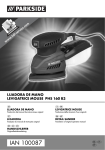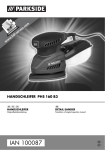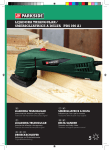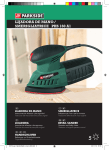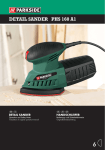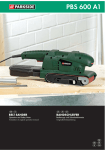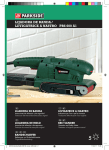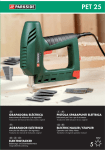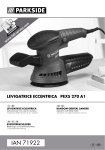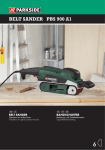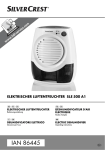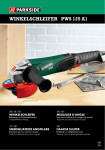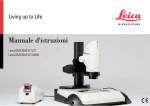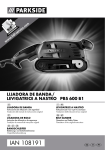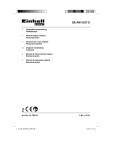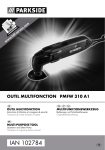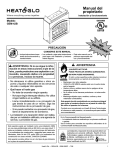Download 46174_DELTA SANDER_Content_LB5new (ohne PT).indd
Transcript
PDS 290 A1 LIJADORA TRIANGULAR SMERIGLIATRICE A DELTA Instrucciones de utilización y de seguridad Traducción del manual de instrucciones original Indicazioni per l’uso e per la sicurezza Traduzione delle istruzioni d’uso originali DELTA SANDER DELTASCHLEIFER Operation and Safety Notes Translation of original operation manual Bedienungs- und Sicherheitshinweise Originalbetriebsanleitung Antes de empezar a leer abra la página que contiene las imágenes y, en seguida, familiarícese con todas las funciones del dispositivo. Prima di leggere aprire la pagina con le immagini e prendere confidenza con le diverse funzioni dell’apparecchio. Before reading, unfold the page containing the illustrations and familiarise yourself with all functions of the device. Klappen Sie vor dem Lesen die Seite mit den Abbildungen aus und machen Sie sich anschließend mit allen Funktionen des Gerätes vertraut. ES IT / MT GB / MT DE / AT / CH Instrucciones de utilización y de seguridad Indicazioni per l’uso e per la sicurezza Operation and Safety Notes Bedienungs- und Sicherheitshinweise Página 5 Pagina 13 Page 23 Seite 31 1 6 2 5 B A 7 C 60 ° 8 D 60 ° 6 0° 6 0° 3 4 60 ° 60 ° Índice Introducción Uso según las normas ..................................................................................................Página Equipamiento ................................................................................................................Página Contenido......................................................................................................................Página Datos técnicos ...............................................................................................................Página 6 6 6 6 Indicaciones generales de seguridad para herramientas eléctricas 1. Seguridad en el lugar de trabajo ...........................................................................Página 2. Seguridad eléctrica..................................................................................................Página 3. Seguridad de las personas .....................................................................................Página 4. Manejo y uso cuidadoso de las herramientas eléctricas .....................................Página Indicaciones de seguridad específicas para este aparato.......................................Página ¿Entendido?...................................................................................................................Página 7 7 8 8 9 10 Puesta en funcionamiento Aspiración del polvo ....................................................................................................Página Adaptador para aspiración externa (con pieza reductora) .....................................Página Colocar / retirar la lija ..................................................................................................Página Girar la placa de lijar en pasos de 60° ....................................................................Página Indicaciones de trabajo ...............................................................................................Página 10 10 11 11 11 Mantenimiento y limpieza.........................................................................Página 11 Asistencia ..................................................................................................................Página 11 Garantía ....................................................................................................................Página 11 Eliminación ..............................................................................................................Página 12 Declaración de conformidad / Fabricante ....................................Página 12 ES 5 Introducción En estas instrucciones de uso / en el aparato se utilizan los siguientes pictogramas: ¡Lea las instrucciones de uso! Clase de protección II ¡Siga las indicaciones de prevención y seguridad! Use gafas de protección, protección auditiva, mascarilla y guantes de protección. ¡Tenga cuidado con las descargas eléctricas! Peligro de vida! ¡Mantener fuera del alcance de los niños! ¡Peligro de explosión! ¡Sólo para uso en interiores! V~ Voltios (Tensión alterna) ¡Peligro de muerte por descarga eléctrica si el cable o el enchufe de red están dañados! W Vatio (Potencia efectiva) ¡Evacue el embalaje y el aparato de forma respetuosa con el medio ambiente! Lijadora triangular PDS 290 A1 Introducción Familiarícese con el funcionamiento del dispositivo antes de ponerlo en marcha e infórmese sobre cómo trabajar adecuadamente con herramientas eléctricas. Para ello, lea las siguientes instrucciones de uso. Guarde estas instrucciones en un lugar seguro. En caso de transferir el aparato a terceros entrégueles también toda la documentación. 1 Interruptor de CONEXIÓN / DESCONEXIÓN 2 Rueda de ajuste preselección número de 3 4 5 6 7 8 Uso según las normas El dispositivo se destina a la rectificación y pulido de madera, plástico, metal, asfalto y superficies barnizadas a seco. Este aparato está especialmente indicado para esquinas, perfiles o zonas de difícil acceso. Cualquier otro uso o modificación del aparato se considera inadecuado y conlleva considerables peligros de accidente. No asumiremos la responsabilidad por los daños ocasionados debido a un uso distinto del adecuado. No apto para uso industrial. 6 ES Equipamiento oscilaciones Cable de alimentación Manguito de aspiración Aberturas de ventilación Placa de lijar (360° giratoria) Adaptador para la aspiración externa Pieza reductora Contenido 1 Lijadora triangular PDS 290 A1 1 Lija 1 Adaptador para aspiración externa 1 Pieza reductora 1 Manual de instrucciones de uso Datos técnicos Absorción nominal (de corriente): 290 W Tensión nominal: 230 V ~ 50Hz Revoluciones nominales: n0 6.000 - 11.000 rpm Introducción / Indicaciones generales de seguridad para herramientas eléctricas Número de vibraciones nominal: Placa de lijar: Clase de protección: n0 12.000 - 22.000 rpm 360° giratoria II / Información sobre ruido y vibración: El valor de medición de ruido se ha calculado según EN 60745. El nivel de ruido ponderado A típico de la herramienta eléctrica corresponde a: Nivel de presión de sonido: 78 dB(A) Nivel de potencia de sonido: 89 dB(A) Tolerancia K: 3 dB ¡Debe llevarse protección auditiva! Aceleración evaluada, empírica: Vibración mano-brazo ah = 6,735 m / s2 Tolerancia K = 1,5 m / s2 ¡ADVERTENCIA! El nivel de vibración indicado en estas instrucciones se ha determinado según un procedimiento de medición fijado en la norma EN 60745 y puede usarse como base para la comparación con otros aparatos. El nivel de vibraciones variará dependiendo del uso de la herramienta eléctrica y puede en muchos casos superar el valor indicado en estas instrucciones. Podría subestimarse la carga de vibraciones si se usa con regularidad la herramienta eléctrica de este modo. Advertencia: Para un cálculo exacto de la carga de oscilación durante un determinado intervalo de trabajo se deben tener en cuenta los tiempos en los que la máquina está desconectada o está conectada pero no está funcionando. Esto podría reducir considerablemente la carga de oscilación en el intervalo total de trabajo. Indicaciones generales de seguridad para herramientas eléctricas ¡ADVERTENCIA! ¡Lea las advertencias e indicaciones de seguridad! El incumplimiento de las advertencias e indicaciones de seguridad puede provocar descargas eléctricas, incendios y / o lesiones graves. ¡GUARDAR TODAS LAS ADVERTENCIAS E INDICACIONES DE SEGURIDAD POR SI LAS NECESITA EN UN FUTURO! EL CONCEPTO UTILIZADO EN LAS INSTRUCCIONES DE SEGURIDAD “HERRAMIENTA ELÉCTRICA” SE REFIERE A APARATOS ELÉCTRICOS OPERADOS DESDE LA RED (CON CABLE DE RED) Y A HERRAMIENTAS ELÉCTRICAS OPERADAS CON BATERÍA (SIN CABLE DE RED). 1. Seguridad en el lugar de trabajo a) Mantenga el lugar de trabajo limpio y bien iluminado. El desorden y los lugares de trabajo mal iluminados pueden provocar accidentes. b) No utilice el aparato en áreas potencialmente explosivas en las que haya líqui dos, gases o polvos inflamables. Las herramientas eléctricas producen chispas que podrían encender el polvo o los vapores. c) Mantenga a los niños y a otras personas alejados de la herramienta eléctrica cuando la esté utilizando. Las distracciones pueden hacerle perder el control del aparato. 2. Seguridad eléctrica Evite el peligro de muerte por descarga eléctrica: a) El enchufe debe ser el adecuado para la toma de corriente. No se debe moES 7 Indicaciones generales de seguridad para herramientas eléctricas b) c) d) e) f) dificar de ningún modo el enchufe del aparato. No utilice nunca adaptadores con los aparatos que están provistos de derivación a tierra. Los conectores sin modificar y las tomas adecuadas reducen el riesgo de descarga eléctrica. Evite el contacto físico con superficies conectadas a tierra, como tubos metálicos, radiadores, cocinas o frigoríficos. Existe un riesgo muy elevado de descarga eléctrica si su cuerpo deriva a tierra. Mantenga el aparato protegido de la lluvia y la humedad. Si penetra agua en un aparato eléctrico aumenta el riesgo de descarga eléctrica. No utilice el cable para otros fines, como para transportar o colgar el aparato o para tirar de la clavija de red al desenchufarlo. Mantenga el cable al resguardo del calor, del aceite, de los bordes afilados o de las piezas móviles del aparato. Los cables dañados o retorcidos aumentan el riesgo de descarga eléctrica. Al trabajar con herramientas eléctricas al aire libre, utilice sólo cables de extensión que también estén autorizados para su uso en exteriores. El uso de una extensión adecuada para su empleo en exteriores disminuye el riesgo de descarga eléctrica. Si es inevitable usar esta herramienta eléctrica en un entorno húmedo, utilice un interruptor de corriente de defecto. El uso de un interruptor de corriente de defecto reduce el riesgo de descarga eléctrica. 3. Seguridad de las personas a) Sea cuidadoso en todo momento, preste atención a lo que hace y proceda con prudencia al trabajar con una herramienta eléctrica. No utilice el aparato si está cansado o si se encuentra bajo el efecto de drogas, alcohol o medicamentos. Un simple momento de descuido durante el uso del aparato podría causar lesiones graves. 8 ES b) c) d) e) f) g) Lleve equipo de protección individual y siempre unas gafas de protección. Si lleva equipo de protección personal, como mascarilla antipolvo, zapatos de seguridad antideslizantes, casco de seguridad o protección auditiva, en función del tipo y la utilización de la herramienta eléctrica, reducirá el riesgo de daños. Evite una conexión accidental del aparato. Asegúrese de que la herramienta eléctrica esté desconectada antes de conectarla al suministro eléctrico, antes de sostenerla o moverla. Si al mover el aparato ha puesto el dedo sobre el interruptor de CONEXIÓN / DESCONEXIÓN o si ha conectado el aparato, podrían producirse accidentes. Extraiga las herramientas de ajuste o llaves antes de encender el aparato. Cualquier herramienta o llave que se encuentre en una pieza giratoria del aparato puede provocar lesiones. Evite posturas inadecuadas. Procure estar en una posición segura y mantenga en todo momento el equilibrio. De este modo podrá controlar mejor el aparato, especialmente en situaciones inesperadas. Utilice ropa adecuada. No use joyas ni ropas flojas. Mantenga su cabello, ropa y guantes alejados de las partes móviles. La ropa floja, las joyas o el pelo largo pueden engancharse en las piezas móviles. Si los dispositivos de aspiración y recolección de polvo están montados, asegúrese de que estén conectados y sean correctamente utilizados. El uso de estos dispositivos disminuye los peligros causados por el polvo. 4. Manejo y uso cuidadoso de las herramientas eléctricas a) No sobrecargue el aparato. Emplee en su trabajo la herramienta eléctrica adecuada para el mismo. Si usa la herramienta adecuada dentro de la potencia indicada trabajará mejor y de forma más segura. Indicaciones generales de seguridad para herramientas eléctricas b) No utilice una herramienta eléctrica cuyo interruptor tenga algún defecto. Una herramienta eléctrica que no se puede encender o apagar es un peligro y debe repararse. c) Retire la clavija del enchufe antes de realizar ajustes en el aparato, cambiar accesorios o depositar el aparato sobre una superficie. Esta medida de precaución evita que se ponga en marcha el aparato por accidente. d) Conserve las herramientas eléctricas que no use fuera del alcance de los niños. No permita utilizar el aparato a personas que no estén familiarizadas con él o que no hayan leído estas indicaciones. Las herramientas eléctricas son peligrosas si las usan personas sin experiencia. e) Cuide el aparato. Compruebe que las piezas móviles funcionen correctamente y no se atasquen, y que no haya piezas rotas o tan dañadas que perjudiquen al funcionamiento del aparato. Haga reparar las piezas dañadas antes de usar el equipo. La causa de muchos accidentes es el uso de herramientas eléctricas que no han recibido el mantenimiento adecuado. f) Utilice la herramienta eléctrica, los accesorios, las herramientas adicionales, etc. de acuerdo con estas indicaciones y del modo que se describe para este tipo de aparato en concreto. Tenga en cuenta las condiciones de trabajo y la actividad que se va a realizar. El uso de herramientas eléctricas para fines diferentes de los previstos puede provocar situaciones peligrosas. Indicaciones de seguridad específicas para este aparato Sujete la pieza de trabajo. Utilice dispositivos de tensión / tornillo de banco para sujetar la pieza de trabajo. Así se mantiene más seguro que con las manos. Proteja siempre sus manos del área lateral y frontal del dispositivo y de las superficies que se van a trabajar, ya que si resbala podría sufrir lesiones. En caso de peligro, extraiga inmediatamente el enchufe de la toma de corriente. Mantenga apartado el cable de red siempre por detrás del aparato. ¡PELIGRO DE INCENDIO POR CHISPAS! Al lijar metales se producen chispas. Por lo tanto, es imprescindible que procure no poner a nadie en peligro y que no haya materiales inflamables en las proximidades del área de trabajo. ¡ADVERTENCIA! ¡VAPORES TÓXICOS! El polvo nocivo / tóxico generado durante el trabajo supone un riesgo para la salud de quien maneja el aparato o de las personas que estén cerca. ¡Lleve gafas de protección y máscara antipolvo! En caso de trabajo prolongado con madera y especialmente si se trabajan materiales que liberen polvo insalubre, conecte el aparato a un dispositivo externo de aspiración de polvo adecuado. Al trabajar plásticos, pinturas, lacas, etc. procure que haya ventilación suficiente. No humedezca los materiales ni las superficies en las que va a trabajar con líquidos que contengan disolvente. No trabaje materiales ligeramente húmedos o superficies mojadas. Evite pulir las pinturas que contienen plomo u otros materiales perjudiciales para la salud. No trabaje con material que contenga amianto. El amianto puede provocar cáncer. Evite el contacto con la lija en movimiento. Utilice el aparato sólo con la lija instalada. Nunca utilice el aparato para un fin distinto al descrito y hágalo sólo con piezas y accesorios originales. El uso de piezas u otros accesorios diferentes a aquellos recomendados en el manual de instrucciones puede suponer un riesgo de lesiones para usted. Una vez desconectado, deje que el aparato se detenga antes de depositarlo. ES 9 Indicaciones generales de seguridad para… / Puesta en funcionamiento El aparato debe mantenerse siempre limpio, seco y libre de aceite o grasas lubricantes. ¿Entendido? Una vez que se haya familiarizado con las indicaciones, funciones y el manejo de este aparato puede comenzar a trabajar. La forma más segura de trabajar es respetar todas las indicaciones y consejos del fabricante. Bajo condiciones adversas, como por ejemplo en caso de chispas, o al pulir el metal o los restos de metal en madera puede encenderse el polvo de madera en la bolsa para polvo (o en la bolsa para polvo de la aspiradora). Esto puede ocurrir especialmente cuando el polvo de la madera está mezclado con restos de laca o de otras sustancias químicas y la pieza a pulir se ha calentado después de haber trabajado con ella por largo tiempo. Por ello, evite a toda costa un recalentamiento de la pieza a pulir y del aparato y antes de hacer una pausa vacíe siempre la caja colectora de polvo o la bolsa para polvo del aspirador. Puesta en funcionamiento ¡PRECAUCIÓN! Antes de conectar el aparato al suministro eléctrico, asegúrese de que está desconectado. Indicación: Conecte la lijadora triangular antes de que entre en contacto con el material y, sólo entonces, acérquela a la pieza de trabajo. Conexión del dispositivo: Coloque el interruptor de conexión / desconexión 1 en la posición „I“. Desconectar el aparato: Coloque el interruptor de conexión / desconexión 1 hacia atrás en la posición „I“. Preseleccionar el número de oscilaciones: En función de la aplicación, puede preseleccionarse el número deseado de oscilaciones mediante la rueda de ajuste 2 . El ajuste puede modificarse incluso durante el trabajo. Averiguará el número de oscilaciones óptimo para sus trabajos haciendo una pequeña prueba. Ajuste 1 = número de oscilaciones más bajo / Ajuste máx. = número de oscilaciones más alto Lleve una máscara de protección contra el polvo. ¡ADVERTENCIA! Antes de efectuar trabajos en el dispositivo, desenchúfelo siempre de la corriente. Adaptador para aspiración externa (con pieza reductora) Conectar: Deslice el adaptador para aspiración externa 7 en el manguito de aspiración 4 . Para ello, tenga en cuenta las indicaciones de guía en el aparato y en el adaptador. Para bloquearlo, gire el manguito de aspiración. En caso necesario utilice la pieza reductora 8 deslizándola en el adaptador 7 . Desplace el conducto de un dispositivo de aspirador (p. ej. de un aspirador para taller) hacia el adaptador para la aspiración externa 7 o la pieza reductora 8 . Retirar: Retire el conducto del dispositivo de aspiración del adaptador para la aspiración externa 7 . Aspiración del polvo Retire el adaptador para aspiración externa 7 ; dado el caso, con la pieza reductora 8 . ¡ADVERTENCIA! ¡PELIGRO DE INCENDIO! Al trabajar con aparatos eléctricos que disponen de una caja colectora de polvo o que pueden estar conectados con el aspirador mediante un dispositivo de aspiración existe peligro de incendio 10 ES Puesta en funcionamiento / Mantenimiento y limpieza / Asistencia / Garantía Colocar / retirar la lija ¡ADVERTENCIA! Antes de efectuar trabajos en el dispositivo, desenchúfelo siempre de la corriente. Mantenimiento y limpieza ¡ADVERTENCIA! Antes de efectuar trabajos en el dispositivo, desenchúfelo siempre de la corriente. Colocar: Puede colocar la lija mediante un cierre con velcro en la placa de lijar 6 . La lijadora triangular no necesita mantenimiento. Limpie regularmente el dispositivo inmediatamente después de finalizar el trabajo. Retirar: Retire simplemente la lija de la placa de lijar 6 (véase fig. B). Girar la placa de lijar en pasos de 60° ¡ADVERTENCIA! Antes de efectuar trabajos en el dispositivo, desenchúfelo siempre de la corriente. Gire la placa para lijar 6 de la lijadora triangular en pasos de 60° hasta que se encaje en la posición deseada (véase fig. C). Remoción y superficie: La forma de la lijadora triangular le permite lijar incluso zonas de difícil acceso, esquinas y cantos (véase fig. D). La potencia de remoción y la claridad de la superficie se determinan a través del granulado de la lija y el número de oscilaciones configurado. Por favor tenga en cuenta que para trabajar los diferentes materiales se necesitan diferentes lijas con diferente granulado y que el número de oscilaciones debe adecuarse al material. Utilice un paño seco para limpiar el aparato. Retire con un pincel el polvo de lijado que haya quedado adherido. Nunca utilice objetos cortantes, gasolina, productos de limpieza o detergentes que sean agresivos para el plástico. No deben entrar líquidos al interior del dispositivo. Mantenga las aberturas para la ventilación 5 siempre libres. ¡ADVERTENCIA! Haga reparar los aparatos únicamente por personal técnico cualificado y con repuestos originales. Así se garantiza que el aparato seguirá siendo seguro. ¡ADVERTENCIA! Si es necesario cambiar el enchufe o el cable de alimentación, encargue este trabajo al fabricante del aparato o a su servicio de atención al cliente. Así se garantiza que el aparato seguirá siendo seguro. Indicaciones de trabajo Acerque el aparato a la pieza de trabajo. Trabaje ejerciendo poca presión. Trabaje con un avance uniforme. Sustituya las hojas de lija a tiempo. No utilice la misma lija para trabajar distintos materiales (p.ej., madera y, después, metal. Sólo con lijas en perfecto estado conseguirá un buen pulido. Limpie frecuentemente la lija con el aspirador de polvo. Asistencia Garantía Con este aparato recibe usted 3 años de garantía desde la fecha de compra. El aparato ha sido fabricado cuidadosamente y ha sido probado antes de su entrega. Guarde el comprobante de caja como justificante de compra. Si necesitara hacer uso de la garantía, póngase en contacto por teléfono con su centro de servicio habitual. Éste es el único modo de garantizar un envío gratuito. ES 11 Garantía / Eliminación / Declaración de conformidad / Fabricante La garantía cubre sólo defectos de fabricación o del material, pero no los daños de transporte, piezas sujetas a desgaste y los daños sufridos por las piezas frágiles p. ej. el interruptor o baterías. Este producto ha sido diseñado exclusivamente para el uso particular y no para el uso industrial. En caso de manipulación indebida e incorrecta, uso de la fuerza y en caso de abrir el aparato personas extrañas a nuestros centros de asistencia técnica autorizados, la garantía pierde su validez. Esta garantía no reduce en forma alguna sus derechos legales. Por el mero hecho de hacer uso de la garantía no implica la prolongación del período de válidez de la garantía. Ello rige también para piezas sustituidas y reparadas. Los posibles daños y defectos detectados al comprar el producto, se han de notificar de inmediato o como muy tarde dos días desde la fecha de compra. Finalizado el periodo de garantía, las reparaciones se han de abonar. ES Kompernass Service España Tel.: 902/884663 e-mail: [email protected] Declaración de conformidad / Fabricante Nosotros, la empresa Kompernaß GmbH, Responsable de la documentación: Señor Dennis Dohm, Burgstr. 21, D-44867 Bochum, Alemania, declaramos que este producto cumple las siguientes normas, documentos normativos y directivas comunitarias: Directiva de máquinas (2006 / 42 / EC) Directiva europea de baja tensión (2006 / 95 / EC) Compatibilidad electromagnética (2004 / 108 / EC) Normas armonizadas aplicadas EN 60745-1:2006 EN 60745-2-4/A11:2007 EN 55014-1:2006 EN 55014-2/A1:2001 EN 61000-3-2:2006 EN 61000-3-3/A2:2005 EN 62233:2008 Tipo / Denominación del aparato: Lijadora triangular PDS 290 A1 Eliminación El embalaje se compone de materiales reciclables que puede desechar en los puntos locales de recogida selectiva. Date of manufacture (DOM): 02 - 2010 Número de serie: IAN 46174 Bochum, 28.02.2010 ¡No tire las herramientas eléctricas en la basura doméstica! Según la Directiva europea 2002 / 96 / EC sobre residuos de aparatos eléctricos y electrónicos y en cumplimiento con el derecho nacional, las herramientas eléctricas usadas se tienen que separar y reciclar sin dañar el medioambiente. Para deshacerse de un aparato que ya no sirva pregunte a las autoridades locales o municipales. 12 ES Hans Kompernaß - Gerente - Queda reservado el derecho a realizar modificaciones técnicas para el perfeccionamiento del dispositivo. Indice Introduzione Utilizzo secondo la destinazione d‘uso......................................................................Pagina Dotazione ......................................................................................................................Pagina Contenuto della confezione ........................................................................................Pagina Dati tecnici ....................................................................................................................Pagina 14 14 14 14 Istruzioni di sicurezza generali per utensili elettrici 1. Sicurezza dell’area di lavoro ..................................................................................Pagina 2. Sicurezza elettrica....................................................................................................Pagina 3. Sicurezza delle persone ..........................................................................................Pagina 4. Utilizzo attento di dispositivi elettrici ......................................................................Pagina Indicazioni di sicurezza specifiche per questo apparecchio ...................................Pagina Capito tutto? .................................................................................................................Pagina 15 15 16 16 17 18 Messa in esercizio Aspirazione di polvere .................................................................................................Pagina Adattatore per l’aspirazione esterna (con riduttore) .................................................Pagina Apposizione / Distacco del foglio abrasivo ...............................................................Pagina Rotazione della piastra di molatura di 60° ...............................................................Pagina Indicazioni relative alla lavorazione ..........................................................................Pagina 18 18 19 19 19 Manutenzione e pulizia................................................................................Pagina 19 Assistenza ................................................................................................................Pagina 19 Garanzia ...................................................................................................................Pagina 20 Smaltimento ...........................................................................................................Pagina 20 Dichiarazione di conformità / Fabbricante ..................................Pagina 21 IT/MT 13 Introduzione In queste istruzioni d'uso / sull'apparecchio sono riportati i seguenti pittogrammi: Leggere il manuale di istruzioni per l’uso! Classe di protezione II Rispettare le avvertenze e le indicazioni per la sicurezza! Indossare occhiali protettivi, protezioni per l’udito, mascherina antipolvere e guanti protettivi. Attenzione, rischio di scossa elettrica! Pericolo di morte! Tenere lontano i bambini dall’apparecchio elettrico! Pericolo di esplosione! Da utilizzare solo in ambienti interni! V~ Volt (tensione alternata) Pericolo di morte a causa di scossa elettrica in presenza di un cavo di alimentazione o di una spina difettosi! W Watt (potenza attiva) Smaltire l’imballaggio dell’apparecchio in modo ecocompatibile! Smerigliatrice a delta PDS 290 A1 Introduzione Prima della messa in servizio dell’apparecchio prendere dimestichezza con le sue funzioni e informarsi sul corretto utilizzo degli utensili elettrici. Al riguardo leggere le seguaenti istruzioni per l’uso, da conservare con cura. L’apparecchio deve essere accompagnato dalla documentazione completa anche in caso di cessione a terzi. 1 Interruttore ON- / OFF 2 Rotellina di preselezione del numero 3 4 5 6 7 8 Utilizzo secondo la destinazione d‘uso L‘apparecchio è destinato alla molatura e alla lucidatura di legno, plastica, metallo, stucco, nonché di superfici lucidate. L’apparecchio è particolarmente adatto per angoli, profili e punti difficilmente raggiungibili. Ogni altro utilizzo, oppure la modifica dell’apparecchio, si considerano come non conformi alla destinazione d’uso, e possono causare seri pericoli d’incidenti. Il produttore non risponde per eventuali danni causati dall‘utilizzo improprio dell’apparecchio. L’apparecchio non è destinato all’utilizzo commerciale. 14 IT/MT Dotazione di oscillazioni Cavo di alimentazione Supportoper aspirazione Aperture di aerazione Piastra di molatura (ruotabile di 360°) Adattatore per aspirazione esterna Riduttore Contenuto della confezione 1 Smerigliatrice a delta PDS 290 A1 1 Foglio abrasivo 1 Adattatore per aspirazione esterna 1 Riduttore 1 Istruzioni d‘uso Dati tecnici Potenza nominale: Tensione nominale: Numero di giri nominale: 290 W 230 V~ 50 Hz n0 6.000 - 11.000 min-1 Introduzione / Istruzioni di sicurezza generali per utensili elettrici Numero di oscillazioni nominale: n0 12.000 - 22.000 min-1 Piastra di molatura: 360° ruotabile Classe di protezione: II / Informazioni relative al rumore e le vibrazioni: I valori di misurazione sono stati accertati in applicazione delle norme EN 60745. Il livello di pressione acustica stimato A ammonta tipicamente a: Livello di pressione acustica: 78 dB(A) Livello di intensità sonora: 89 dB(A) Scostamento di K: 3 dB Utilizzare strumenti di protezione dell‘udito! Accelerazione valutata, tipica: Vibrazione mano / braccio ah = 6,735 m / s2 Scostamento K = 1,5 m / s2 ATTENZIONE! Il valore relativo al livello di vibrazioni indicato nelle presenti istruzioni d’uso è stato misurato in conformità alla procedura di misurazione esplicata nella norma EN 60745 e può essere utilizzato per il confronto tra apparecchi. Il livello di vibrazioni si modifica a seconda del tipo di utilizzo dell’apparecchio elettrico, ed in alcuni casi può essere superiore al valore indicato nelle presenti istruzioni d’uso. Il carico di vibrazione potrebbe essere sottostimato qualora l’apparecchio elettrico fosse regolarmente utilizzato in tale modo. Nota: Per una corretta valutazione dell’affaticamento da vibrazioni durante un determinato periodo di lavorazione devono essere considerati anche i tempi in cui l’apparecchio è disinserito o è funzionante, senza però essere utilizzato. Ciò può ridurre in misura notevole l’affaticamento da vibrazioni lungo il periodo di lavorazione complessivo. Istruzioni di sicurezza generali per utensili elettrici ATTENZIONE! Leggere tutte le indicazioni e gli avvisi di sicurezza! Eventuali mancanze nell’osservanza delle indicazioni e degli avvisi di sicurezza possono provocare una scossa elettrica, un incendio e / o gravi lesioni. CONSERVARE TUTTE LE INDICAZIONI E GLI AVVISI DI SICUREZZA PER EVENTUALI NECESSITA’ FUTURE! LA PAROLA „ATTREZZO ELETTRICO“ UTILIZZATA NELLE ISTRUZIONI D’USO SI RIFERISCE AGLI ATTREZZI ELETTRICI FUNZIONANTI ALL’INTERNO DI UNA RETE (CON CAVO DI RETE) E AGLI ATTREZZI ELETTRICI CHE FUNZIONANO MEDIANTE BATTERIE (SENZA CAVO DI RETE). 1. Sicurezza dell’area di lavoro a) Mantenere l’area di lavoro pulita e ben illuminata. Il disordine ed aree di lavoro poco illuminate possono determinare incidenti. b) Non lavorare con l’apparecchio in un’atmosfera dove si trovino liquidi infiammabili, esplosiva, gas e polveri. Gli utensili elettrici generano scintille che possono infiammare la polvere o i gas. c) Durante l’utilizzo del dispositivo elettrico tenere lontani bambini e persone estranee. In caso di distrazione potreste perdere il controllo dell’apparecchio. 2. Sicurezza elettrica Evitare il pericolo di morte a seguito di scossa elettrica: a) La spina di connessione dell’apparecchio deve essere adatta alla presa elettrica nella quale essa viene inserita. In nessun caso l’adattatore deve essere modificato. Non utilizzare spine IT/MT 15 Istruzioni di sicurezza generali per utensili elettrici b) c) d) e) f) con apparecchi messi a terra. Spine non modificate e prese adatte riducono il rischio di una scossa elettrica. Evitare il contatto del corpo con superfici messe a terra, quali ad esempio quelle di tubi, caloriferi, cucine economiche e frigoriferi. Sussiste un elevato rischio di scossa elettrica, qualora il Vostro corpo fosse messo a terra. Mantenere l’apparecchio lontano da pioggia o umidità. La penetrazione di acqua in un apparecchio elettrico accresce il rischio di scossa elettrica. Non utilizzare il cavo in modo non conforme, cioè per tirare l’apparecchio, per appenderlo o per estrarre la spina dalla presa elettrica. Tenere il cavo lontano da calore, olio, spigoli acuti o di parti in movimento dell’apparecchio. Cavi danneggiati o attorcigliati accrescono il rischio di scossa elettrica. In caso di lavori all’aperto utilizzare solamente prolunghe ammesse anche per un loro utilizzo all‘aperto. L’utilizzo di una tale prolunga riduce il rischio di scossa elettrica. Qualora non si possa evitare l‘esercizio dell’elettroutensile in un ambiente umido, fare uso di un interruttore differenziale, circostanza che riduce il rischio di una scossa elettrica. 3. Sicurezza delle persone a) Fare sempre estrema attenzione a ciò che si fa e accostarsi al lavoro con il dispositivo elettrico sempre in modo cosciente. Non utilizzare l’apparecchio quando si è stanchi o sotto l’influsso di droghe, alcol o medicinali. Un solo attimo di disattenzione nell’utilizzo dell’apparecchio può provocare serie lesioni. b) Indossare sempre l’equipaggiamento di protezione personale e gli occhiali protettivi. Indossando l’equipaggiamento di protezione personale, quale una mascherina antipolvere, 16 IT/MT c) d) e) f) g) scarpe di sicurezza antisdrucciolevoli, un casco di protezione o una protezione auricolare, a seconda del tipo e dell’utilizzo dell’apparecchiatura elettrica, riduce il rischio di lesioni. Evitare qualsiasi avvio involontario dell’utensile. Assicurarsi che l’utensile sia disinserito prima di collegarlo alla rete di alimentazione elettrica, di sollevarlo o di trasportarlo. Se durante il trasporto dell’apparecchio il dito dell’utilizzatore si trova sull’interruttore ON / OFF oppure l’apparecchio è inserito, possono determinarsi incidenti. Prima di avviare l’apparecchio, rimuovere il dispositivo di regolazione o la chiave per dadi. Un utensile o una chiave che si trovi in una parte di apparecchio in rotazione può provocare lesioni. Mantenere una postura del corpo normale. Assicurarsi di avere un sostegno sicuro e mantenere sempre l’equilibrio. In questo modo è possibile controllare meglio l’apparecchio, in modo particolare in caso di situazioni impreviste. Indossare un abbigliamento appropriato. Non indossare un abbigliamento largo o bigiotteria. Mantenere capelli, abbigliamento e guanti lontano da parti in movimento. Abbigliamento sciolto, gioielli o capelli lunghi possono essere trascinati da parti in movimento. Quando vengono montati dispositivi di aspirazione e di cattura della polvere, assicurarsi che questi siano stati montati ed utilizzati correttamente. L’utilizzo di questi dispositivi riduce i pericoli provocati dalla polvere. 4. Utilizzo attento di dispositivi elettrici a) Non sovraccaricare l’apparecchio. Per un determinato lavoro utilizzare sempre il dispositivo elettrico a ciò appropriato. Con il dispositivo elettrico appropriato si lavora meglio e con maggiore sicurezza nello specifico ambito di utilizzo. Istruzioni di sicurezza generali per utensili elettrici b) Non utilizzare dispositivi elettrici il cui interruttore sia difettoso. Un dispositivo elettrico che non si può più accendere e spegnere rappresenta un pericolo, e deve essere riparato. c) Estrarre la spina dalla presa elettrica prima di eseguire regolazioni all‘apparecchio, di sostituire di accessori o di riporre l’apparecchio. Queste misure di prudenza impediscono l’avvio involontario dell’apparecchio. d) Mantenere dispositivi elettrici non utilizzati fuori dalla portata di bambini. Non fare utilizzare l’apparecchio da persone che non lo conoscano o del quale non abbiano letto le istruzioni d’uso. I dispositivi elettrici sono pericolosi se utilizzati da persone inesperte. e) Avere cura dell’apparecchio. Controllare se parti mobili dell’apparecchio funzionano perfettamente e non si bloccano, se parti di esso sono rotte o danneggiate, che la funzionalità dell’apparecchio non sia messa a rischio. Fare riparare le parti danneggiate prima di utilizzare di nuovo l’apparecchio. Molti incidenti sono provocati dal fatto che i dispositivi elettrici non vengono sottoposti ad una corretta manutenzione. f) Utilizzare dispositivi elettrici, accessori, i dispositivi da inserire ecc, in conformità alle presenti istruzioni e nel modo descritto per questo particolare tipologia di apparecchio. In questo senso, tenere presente le condizioni di lavoro e l’attività da eseguire. L’utilizzo di dispositivi elettrici per scopi diversi da quelli previsti può provocare situazioni di pericolo. Indicazioni di sicurezza specifiche per questo apparecchio Bloccare il pezzo da lavorare. A questo scopo utilizzare dispositivi di bloccaggio / una morsa a vite attorno al pezzo. Esso viene in questo modo trattenuto in modo più sicuro che non con la mano. In nessun caso appoggiarsi con la mani nei pressi dell’apparecchio, oppure davanti ad esso e alla superficie di lavorazione, dal momento che in caso di scivolamento sussiste il pericolo di lesione. In caso di pericolo estrarre subito il cavo di alimentazione dalla presa di rete. Portare il cavo sempre verso la parte posteriore dell’apparecchio. PERICOLO DI INCENDIO A CAUSA DELLE SCINTILLE GENERATE NEL CORSO DELLA LAVORAZIONE! In caso di molatura di metalli, vengono generate scintille. Fare assolutamente attenzione a che nessuna persona sia in pericolo e che non si trovino materiali infiammabili nelle vicinanze dell’area di lavoro. ATTENZIONE! GAS NOCIVI! La lavorazione di polveri dannose o velenose rappresenta un pericolo per la salute degli operatori o delle persone che si trovano nei pressi dell’area di lavoro. Indossare occhiali di protezione e mascherina antipolvere! In caso di lavorazione protratta nel tempo di legno e soprattutto di materiali che generano polveri pericolose per la salute, collegare l’apparecchio ad un sistema esterno di aspirazione adatto allo scopo. Assicurare una sufficiente aerazione in caso di lavorazione di materiale plastico, colori, vernici, ecc. Non impregnare materiali o superfici da lavorare con liquidi contenenti solventi. Non lavorare materiali umidi oppure superfici bagnate. Evitare la molatura di colori contenenti piombo o altri materiali pericolosi per la salute. E‘ vietato lavorare materiale contenente asbesto. Si ritiene che l’asbesto sia una sostanza cancerogena. Nel corso dell’utilizzo, non toccare il foglio abrasivo. Utilizzare l’apparecchio solamente con foglio abrasivo montato. Non utilizzare mai l’apparecchio per uno scopo diverso rispetto a quello previsto, e solo con pezzi e ricambi originali. L’utilizzo di componenti diversi rispetto a quelli suggeriti nelle IT/MT 17 Istruzioni di sicurezza generali per utensili elettrici / Messa in esercizio istruzioni d’uso o di accessori differenti può rappresentare per l’utilizzatore un pericolo di lesione. Sempre spegnere e far terminare la corsa dell’apparecchio prima di riporlo. L’apparecchio deve essere sempre pulito, asciutto e privo di tracce di olio o di grasso. Capito tutto? Una volta che l’utilizzatore si è familiarizzato con le indicazioni, le funzioni ed il modo di maneggiare l‘apparecchio, è possibile iniziare a lavorare. Se si tiene conto di tutte le indicazioni ed avvertimenti, si lavora nella massima sicurezza. Messa in esercizio ATTENZIONE! Prima di inserire l’apparecchio, assicurarsi che esso sia collegato con la rete di alimentazione elettrica. Nota: Inserire la smerigliatrice a delta sempre prima del contatto con il materiale, e solo successivamente guidarla sul pezzo da lavorare. Accensione dell‘apparecchio: Spingere in avanti l’interruttore ON- / OFF 1 in posizione „I”. ATTENZIONE! PERICOLO DI INCENDIO! Utilizzare dispositivi di aspirazione o di cattura della polvere, qualora questi possano essere montati. Lavorando con apparecchi elettrici forniti di un sacchetto per la polvere, o che possono essere collegati con un apparecchio corrispondente, sussiste un pericolo di incendio! In condizioni sfavorevoli, ad esempio nel caso in cui vengano generate scintille levigando il metallo o resti di metallo nel legno, la polvere di legno può prendere fuoco nel sacchetto della polvere (o nel sacchetto del filtro dell’aspirapolvere). Ciò può accadere in modo particolare qualora la polvere di legno sia mescolata con resti di verniciatura o altri prodotti chimici, ed il pezzo molato è caldo dopo un lavoro durato lungo tempo. Si prega quindi di evitare assolutamente un surriscaldamento del pezzo da levigare e dell’apparecchio, e prima di effettuare pause nella lavorazione svuotare sempre il sacchetto della polvere e del filtro dell’aspirapolvere. Indossare sempre una mascherina antipolvere! ATTENZIONE! Prima di eseguire qualsiasi intervento sull’apparecchio estrarre la spina dalla presa. Spegnimento dell‘apparecchio: Spingere indietro l’interruttore ON- / OFF 1 in posizione „0”. Preselezione del numero di oscillazioni: Il numero di oscillazioni desiderato può essere preselezionato secondo le esigenze particolari dell’utilizzatore operando sulla rotellina di preselezione del numero di oscillazioni 2 . La regolazione può avvenire anche nel corso della lavorazione. Il numero di oscillazioni ottimale per le singole lavorazioni viene rilevato attraverso un test pratico. Regolazione 1 = numero di oscillazioni più basso / Regolazione max. = Numero di oscillazioni massimo 18 IT/MT Aspirazione di polvere Adattatore per l’aspirazione esterna (con riduttore) Collegamento: Spingere l’adattatore per l’aspirazione esterna 7 nel supporto per aspirazione 4 . Fare attenzione alle guide poste sull’apparecchio e sull‘adattatore. Per determinarne la chiusura, ruotare il supporto per aspirazione. Se necessario, utilizzare il riduttore 8 , spingendolo nell‘adattatore 7 . Spingere il tubo flessibile di un dispositivo di aspirazione ammesso (ad esempio di un aspirapolvere industriale) sull’adattatore per aspirazione esterna 7 o sul riduttore 8 . Messa in esercizio / Manutenzione e pulizia / Assistenza Estrazione: Sfilare il tubo flessibile del dispositivo di aspirazione dall‘adattatore per aspirazione esterna 7 . Sfilare l‘adattatore per aspirazione esterna 7 se necessario con il riduttore 8 . Apposizione / Distacco del foglio abrasivo ATTENZIONE! Prima di eseguire qualsiasi intervento sull’apparecchio estrarre la spina dalla presa. Applicazione: E‘ possibile applicare il foglio abrasivo alla piastra di molatura per mezzo di una chiusura con velcro 6 . Rimozione: Semplicemente rimuovere il foglio abrasivo dalla piastra di molatura 6 (vedi fig. B). Rotazione della piastra di molatura di 60° ATTENZIONE! Prima di eseguire qualsiasi intervento sull’apparecchio estrarre la spina dalla presa. Ruotare la piastra di molatura 6 della smerigliatrice a delta in passi da 60°, fino a quando essa ha raggiunto la posizione desiderata (vedi fig. C). Asportazione e superficie: La forma della smerigliatrice a delta permette una molatura anche in punti difficilmente raggiungibili, angoli e spigoli (vedi fig. D). La capacità di asportazione ed il grado della superficie vengono determinati dalla granulometria del foglio abrasivo utilizzato e dal numero di oscillazioni impostato. Si prega di fare attenzione a che, per la lavorazione di materiali diversi, vengano utilizzati fogli abrasivi adatti e caratterizzati da differente granulometria, e che il numero di oscillazioni venga egualmente adeguato al tipo di materiale. Indicazioni relative alla lavorazione Condurre l’apparecchio verso il materiale da lavorare solo se esso è in funzione. Lavorare con una bassa pressione di contatto. Lavorare con una spinta uniforme. Sostituire i fogli abrasivi per tempo. Non molare mai differenti materiali (ad esempio legno, e successivamente metallo) con lo stesso foglio abrasivo. Solo con fogli abrasivi in perfetto stato è possibile raggiungere buoni risultati di molatura. Pulire ripetutamente il foglio abrasivo con l‘aspirapolvere. Manutenzione e pulizia ATTENZIONE! Prima di eseguire qualsiasi intervento sull’apparecchio estrarre la spina dalla presa. La smerigliatrice a delta non necessità di alcuna manutenzione. Pulire regolarmente l’apparecchio subito dopo la conclusione del ciclo di lavorazione. Per la pulizia dell’alloggiamento utilizzare un panno asciutto. Rimuovere con un pennello la polvere di molatura che dovesse essersi eventualmente attaccata. In nessun caso utilizzare benzina, solventi o detergenti che possano corrodere la materia plastica. Nessun liquido deve penetrare fino all’interno dell’apparecchio. Lasciare sempre libere le aperture di aerazione 5 . Assistenza ATTENZIONE! Affidare la riparazione dell’apparecchio esclusivamente a personale specializzato e qualificato e con pezzi di ricambio originali, a garanzia della sicurezza dell’apparecchio. ATTENZIONE! La sostituzione della spina o del cavo di alimentazione IT/MT 19 Assistenza / Garanzia / Smaltimento deve essere eseguita esclusivamente dal fabbricante dell’apparecchio o dal relativo servizio clienti, a garanzia della sicurezza dell’apparecchio. Garanzia Questo apparecchio è garantito per tre anni a partire dalla data di acquisto. L’apparecchio è stato prodotto con cura e debitamente collaudato prima della consegna. Conservare lo scontrino come prova d’acquisto. In caso di interventi in garanzia, contattare telefonicamente il proprio centro di assistenza. Solo in questo modo è possibile garantire una spedizione gratuita della merce. La garanzia vale solo per i difetti di materiale o fabbricazione, non per i danni da trasporto, parti soggette a usura o danni a parti fragili come ad es. interruttori o accumulatori. Il prodotto è destinato esclusivamente all’uso domestico e non a quello commerciale. La garanzia decade in caso di impiego improprio o manomissione, uso della forza e interventi non eseguiti dalla nostra filiale di assistenza autorizzata. Questa garanzia non costituisce alcun limite ai diritti legali del consumatore. Il periodo di garanzia non viene prolungato in caso di un intervento in garanzia. Ciò vale anche per le componenti sostituite e riparate. I danni e difetti presenti già all’acquisto devono essere comunicati immediatamente dopo il disimballaggio, e non oltre due giorni dalla data di acquisto. Le riparazioni effettuate dopo la scadenza del periodo di garanzia sono a pagamento. IT Kompernass Service Italia Tel.: 199 400 441 (0,12 EUR/Min.) e-mail: [email protected] 20 IT/MT Smaltimento L’imballaggio è composto da materiali ecologici, che possono essere smaltiti presso i siti di riciclaggio locali. Non gettare gli utensili elettrici nei rifiuti domestici! In conformità alla direttiva europea 2002 / 96 / EC sui rifiuti di apparecchiature elettriche ed elettroniche e relativa trasposizione nel diritto nazionale, gli utensili elettrici usati devono essere raccolti separatamente e riciclati in maniera compatibile con l’ambiente. Informazioni sulle possibilità di smaltimento di apparecchi giunti al termine della loro vita utile sono disponibili presso le amministrazioni comunali. Dichiarazione di conformità / Fabbricante Dichiarazione di conformità / Fabbricante Noi, Kompernaß GmbH, responsabile per la documentazione: sig. Dennis Dohm, Burgstr. 21, D-44867 Bochum, Germania, dichiarano con la presente che questo prodotto è conforme con le seguenti norme, documenti normativi e direttive dell’Unione Europea: Direttiva macchine (2006 / 42 / EC) Direttiva CE sulla bassa tensione (2006 / 95 / EC) Compatibilità elettromagnetica (2004 / 108 /EC) Norme utilizzate ed armonizzate EN 60745-1:2006 EN 60745-2-4/A11:2007 EN 55014-1:2006 EN 55014-2/A1:2001 EN 61000-3-2:2006 EN 61000-3-3/A2:2005 EN 62233:2008 Tipo / Denominazione dell’apparecchio: Smerigliatrice a delta PDS 290 A1 Date of manufacture (DOM): 02 - 2010 Numero di serie: IAN 46174 Bochum, 28.02.2010 Hans Kompernaß - Amministratore - Si riservano modifiche tecniche ai fini di ulteriori sviluppi. IT/MT 21 22 Table of contents Introduction Proper use .....................................................................................................................Page Features and equipment...............................................................................................Page Included items ...............................................................................................................Page Technical information ...................................................................................................Page 24 24 24 24 General safety advice for electrical power tools 1. Workplace safety .....................................................................................................Page 2. Electrical safety ........................................................................................................Page 3. Personal safety .........................................................................................................Page 4. Careful handling and use of electrical power tools ..............................................Page Safety advice relating specifically to this device .......................................................Page Have you understood everything? ..............................................................................Page 25 25 26 26 27 27 Preparing for use Vacuum dust extraction ................................................................................................Page Adapter for external vacuum extraction (with reducer piece) ..................................Page Attaching / detaching sanding sheets .........................................................................Page Turn the backing plate in 60° steps ............................................................................Page Advice on use ...............................................................................................................Page 28 28 28 28 29 Maintenance and cleaning ........................................................................Page 29 Service centre .......................................................................................................Page 29 Warranty ..................................................................................................................Page 29 Disposal ......................................................................................................................Page 30 Declaration of Conformity / Manufacturer..................................Page 30 GB/MT 23 Introduction The following pictograms are used in these operating instructions / on the device: Read instruction manual! Safety class II Observe caution and safety notes! Wear hearing protection, dust protection mask, protective glasses and protective gloves. Caution – electric shock! Danger to life! Keep children away from electrical power tools! Explosive material! For indoor use only! V~ Volt (AC) Risk of loss of life by electric shock from damaged mains lead or mains plug! W Watts (Effective power) Dispose packaging and appliance in an environmentally-friendly way! Delta sander PDS 290 A1 Introduction Please make sure you familiarise yourself fully with the way the device works before you use it for the first time and that you understand how to handle electrical power tools correctly. To help you do this please read the accompanying operating instructions. Keep these instructions in a safe place. If you pass the device on to anyone else, please ensure that you also pass on all the documentation. Proper use The device is intended for dry sanding and polishing of wood, plastic, metal, filler and painted surfaces. The device is particularly suitable for corners, profiles or difficult to access places. Any other use or modification to the device shall be considered as improper use and could give rise to considerable dangers. We will not accept liability for loss or damage arising from improper use. Not suitable for commercial use. 24 GB/MT 1 2 3 4 5 6 7 8 Features and equipment ON / OFF switch Oscillation speed setting wheel Mains lead Dust extraction spout Ventilation openings Backing plate (360° rotatable) Adapter for external vacuum extraction Reducer piece Included items 1 Delta sander PDS 290 A1 1 Sanding sheet 1 Adapter for external vacuum extraction 1 Reducer piece 1 Operating instructions Technical information Nom. power input: Rated voltage: Nominal speed: Nom. oscillation speed: Backing plate: Protection class: 290 W 230V ~ 50 Hz n0 6,000 - 11,000 min-1 n0 12,000 - 22,000 min-1 360° rotatable II / Introduction / General safety advicefor electrical power tools Noise and vibration data: Measured values for noise are determined in accordance with EN 60745. The A-weighted noise level of the electrical power tool are typically: Sound pressure level: 78 dB(A) Sound power level: 89 dB(A) Uncertainty K: 3 dB Wear ear protection! Evaluated acceleration, typical: Hand / arm vibration ah = 6,735 m / s2 Uncertainty K = 1,5 m / s2 WARNING! The vibration level given in these instructions has been measured in accordance with a standardised measurement procedure specified in EN 60745 and can be used to compare devices. Different uses of the device give rise to different vibration levels and in many cases they may exceed the values given in these instructions. It is easy to underestimate the vibration load if the electrical power tool is used regularly in particular circumstances. Note: If you wish to make an accurate assessment of the vibration loads experienced during a particular period of working, you should also take into account the intervening periods of time when the device is switched off or is running but is not actually in use. This can result in a much lower vibration load over the whole of the period of working. General safety advice for electrical power tools WARNING! Read all the safety advice and instructions! Failure to observe the safety advice and instructions may result in electric shock, fire and / or serious injury. KEEP ALL THE SAFETY ADVICE AND INSTRUCTIONS IN A SAFE PLACE FOR FUTURE REFERENCE! THE TERM “ELECTRICAL TOOL” USED IN THE SAFETY ADVICE REFERS TO ELECTRICAL TOOLS POWERED BY MAINS ELECTRICITY (BY MEANS OF A MAINS LEAD) AND ELECTRICAL TOOLS POWERED BY RECHARGEABLE BATTERIES (WITHOUT A MAINS LEAD). 1. Workplace safety a) Keep your working area clean and well lit. Untidy or poorly lit working areas can lead to accidents. b) Do not work with the device in potentially explosive environments in which there are inflammable liquids, gases or dusts. Electrical power tools create sparks, which can ignite dusts or fumes. c) Keep children and other people away while you are operating the electrical tool. Distractions can cause you to lose control of the device. 2. Electrical safety To avoid danger to life from electric shock: a) The mains plug on the device must match the mains socket. The plug must not be modified in any way. Do not use an adapter plug with devices fitted with a protective earth. Unmodified plugs and matching sockets reduce the risk of electric shock. b) Avoid touching earthed surfaces such as pipes, radiators, ovens and refrigerators with any part of your body. There is an increased risk of electric shock if your body is earthed. c) Keep the device away from rain or moisture. Water entering an electrical device increases the risk of electric shock. d) Do not use the mains lead for any purpose for which it was not intended, e.g. to carry the device, to hang up the device or to pull GB/MT 25 General safety advicefor electrical power tools the mains plug out of the mains socket. Keep the mains lead away from heat, oil, sharp edges or moving parts of the device. Damaged or tangled mains leads increase the risk of electric shock. e) When working outdoors with an electrical power tool always use extension cables that are also approved for use outdoors. The use of an extension cable suitable for outdoor use reduces the risk of electric shock. f) Use a residual current device (RCD) for protection if operating the electrical power tool in a moist environment is unavoidable. The use of an RCD reduces the risk of electric shock. 3. Personal safety a) Remain alert at all times, watch what you are doing and always proceed with caution. Do not use the device if you are tired or under the influence of drugs, alcohol or medication. One moment of carelessness when using the device can lead to serious injury. b) Wear personal protective equipment and always wear safety glasses. The wearing of personal protective equipment such as dust masks, non-slip safety shoes, safety helmets or ear protectors, appropriate to the type of electrical power tool used and work undertaken, reduces the risk of injury. c) Avoid unintentional operation of the device. Check that the electrical power tool is switched off before you connect it to the mains, pick it up or carry it. Accidents can happen if you carry the device with your finger on the ON / OFF switch or with the device switched on. d) Remove any setting tools or spanners before you switch the device on. A tool or spanner left attached to a rotating part of a device can lead to injury. e) Avoid placing your body in an unnatural position. Keep proper footing and balance at all times. By doing this 26 GB/MT you will be in a better position to control the device in unforeseen circumstances. f) Wear suitable clothing. Do not wear loose clothing or jewellery. Keep your hair, clothing and gloves clear of moving parts. Loose clothing, jewellery or long hair can become trapped in moving parts. g) If vacuum dust extraction and collection devices are fitted do not forget to check that they are properly connected and correctly used. The use of these devices reduces the hazard presented by dust. 4. Careful handling and use of electrical power tools a) Do not overload the device. Always use an electrical power tool that is intended for the task you are undertaking. By using the right electrical power tool for the job you will work more safely and achieve a better result. b) Do not use an electrical power tool if its switch is defective. An electrical power tool that can no longer be switched on and off is dangerous and must be repaired. c) Pull the mains plug out of the socket before you make any adjustments to the device, change accessories or when the device is put away. This precaution is intended to prevent you from unintentionally starting the device. d) When not in use always ensure that electrical power tools are kept out of reach of children. Do not let anyone use the device if he or she is not familiar with it or has not read the instructions and advice. Electrical power tools are dangerous when they are used by inexperienced people. e) Look after the device carefully. Check that moving parts are working properly and move freely. Check for any parts that are broken or damaged enough to detrimentally affect the functioning of the device. Have damaged parts repaired before you use the General safety advicefor electrical power tools / Preparing for use f) device. Many accidents have their origins in poorly maintained electrical power tools. Use the electrical power tool, accessories, inserted tools etc. in accordance with these instructions and advice, and the stipulations drawn up for this particular type of device. In doing this, take into account the working conditions and the task in hand. The use of electrical power tools for purposes other than those intended can lead to dangerous situations. Do not soak the materials or the surface you Safety advice relating specifically to this device Securely support the workpiece. Use clamps or a vice to grip the workpiece firmly. This is much safer than holding it in your hand. Never support yourself by placing your hands near or in front of the device or the workpiece surface. A slip can result in injury. If a dangerous situation arises, pull the mains plug immediately out of the mains socket. Always work with the mains lead leading away from the rear of the device. DANGER OF FIRE FROM FLYING SPARKS! Abrading metal creates flying sparks. For this reason, always make sure that nobody is placed in any danger and that there are no inflammable materials near the working area. WARNING! NOXIOUS FUMES! Any harmful / noxious dusts generated from sanding represent a risk to the health of the person operating the device and to anyone near the work area. Wear protective glasses and a dust mask! When sanding wood and in particular when working on materials that give rise to dusts that are hazardous to health, the sander must be connected to a suitable external dust extraction device. Ensure that there is adequate ventilation when working on plastic, paint, varnish etc. are about to work on with liquids containing solvents. Do not abrade moistened materials or damp surfaces. Avoid sanding paints containing lead or other substances hazardous to health. Do not work on materials containing asbestos. Asbestos is a known carcinogen. Avoid contact with the moving sanding sheet. Operate the device only with an attached sanding sheet. Never use the device for a purpose for which it was not intended nor with non-original parts / accessories. The use of tools or accessories other than those recommended in the operating instructions could lead to you suffering an injury. Switch the device off and allow it to come to a standstill before you put it down. Always keep the device clean, dry and free of oil or grease. Have you understood everything? Once you have made yourself familiar with the instructions and advice, the functioning and handling of your device, you are finally in a position to start work. Observing the manufacturer‘s instructions and advice will maximise your safety while working with the device. Preparing for use CAUTION! Make sure that the device is switched off before you connect it to the mains supply. Note: Always switch on the delta sander before bringing it into contact with the workpiece material. Switching on the device: Move the ON / OFF switch 1 forwards into setting “I”. GB/MT 27 Preparing for use Switching off the device: Move the ON / OFF switch 1 backwards into setting “0”. Selecting the oscillation speed: You can preselect the oscillation speed you require using the oscillation speed setting wheel 2 . You can also change the speed whilst you are working. The way to determine the optimum oscillation speed for your task is to carry out a practical test. Setting 1 = lowest oscillation speed / Setting max. = highest oscillation speed Vacuum dust extraction WARNING! DANGER OF FIRE! There is the danger of fire when working with electrical devices that have a dust box or can be connected to a vacuum cleaner. Under certain conditions the wood dust in the dust extraction bag (or in the vacuum‘s dust bag) may ignite, e.g. as a result of flying sparks generated when abrading metals or metal objects left in wood. This can happen particularly if the wood dust is mixed with paint residue or other chemicals and the abraded particles are hot from prolonged abrasion. Therefore you must empty the device’s dust collection box and the vacuum cleaner’s dust bag before taking a break or stopping work and always avoid overheating of the abraded particles and the device. When doing this observe the guide markings on the device and adapter. Turn the dust extraction spout to lock in place. If it is necessary to use the reducer piece 8 , push the reducer piece into the adapter for external vacuum extraction 7 . Push the hose of a suitable dust extraction de vice approved for that purpose (e.g. a workshop vacuum cleaner) on to the adapter for external vacuum extraction 7 or the reducer piece 8 . Removal: Pull the hose of the dust extraction device off the adapter for external vacuum extraction 7 . Pull off the adapter for external vacuum extraction 7 (with the reducer piece 8 if used). Attaching / detaching sanding sheets WARNING! Always pull the mains plug is out of the socket before doing any work on the device. Attaching: Sanding sheets are attached to the backing plate 6 by means of the hook and pile fastening. Detaching: Simply pull the sanding sheet off the backing plate 6 (see Fig. B). Wear a dust mask! WARNING! Always pull the mains plug is out of the socket before doing any work on the device. Adapter for external vacuum extraction (with reducer piece) Connection: Push the adapter for external vacuum extraction 7 into the dust extraction spout 4 . 28 GB/MT Turn the backing plate in 60° steps WARNING! Always pull the mains plug out of the socket before doing any work on the device. Turn the backing plate 6 of the delta sander in 60° steps until it engages in the desired position (see Fig. C). Sanding and surfaces: The shape of the delta sander allows you to sand workpieces even in their difficult to access places, corners and edges (see Fig. D). Preparing for use / Maintenance and cleaning / Service centre / Warranty Sanding performance and surface quality depend on the grade of sanding sheet and the oscillation speed setting. Always use sanding sheets with grades that are suitable for the particular surface you are sanding. The speed selected should also be appropriate to the task undertaken. parts only. This will ensure that your device remains safe to use. WARNING! If the plug or mains lead needs to be replaced, always have the replacement carried out by the manufacturer or its service centre. This will ensure that your device remains safe to use. Advice on use Switch the device on before placing it against the workpiece. Apply light sanding pressure only. Advance the device at an even rate. Change sanding sheets at the appropriate time. Do not work on different types of material using the same sanding sheet (e.g. wood and then metal). To achieve the best sanding results you should use unworn, undamaged sanding sheets. Clean the sanding sheet from time to time with a vacuum cleaner. Maintenance and cleaning WARNING! Always pull the mains plug out of the socket before doing any work on the device. The delta sander is maintenance-free. Clean the device frequently. This should be done immediately after you have finished using it. For cleaning the housing use a dry cloth only. Remove any adhering sanding dust with a narrow paint brush. Never any kind of sharp object or petrol, solvents or cleaning agents that might attack plastic. Do not allow any liquids to enter the inside of the device. Always keep the ventilation slots 5 clear. Service centre WARNING! Have your device repaired only by qualified specialist personnel using original manufacturer Warranty The warranty for this appliance is for 3 years from the date of purchase. The appliance has been manufactured with care and meticulously examined before delivery. Please retain your receipt as proof of purchase. In the event of a warranty claim, please make contact by telephone with our Service Department. Only in this way can a post-free despatch for your goods be assured. The warranty covers only claims for material and maufacturing defects, but not for transport damage, for wearing parts or for damage to fragile components, e.g. buttons or batteries. This product is for private use only and is not intended for commercial use. The warranty is void in the case of abusive and improper handling, use of force and internal tampering not carried out by our authorized service branch. Your statutory rights are not restricted in any way by this warranty. The warranty period will not be extended by repairs made unter warranty. This applies also to replaced and repaired parts. Any damage and defects extant on purchase must be reported immediately after unpacking the appliance, at the latest, two days after the purchase date. Repairs made after the expiration of the warranty period are subject to payment. GB DES UK LTD Tel.: 0871 5000 700 (£ 0.10 / minute) e-mail: [email protected] GB/MT 29 Disposal / Declaration of Conformity / Manufacturer Disposal The packaging is wholly composed of environmentally-friendly materials that can be disposed of at a local recycling centre. Do not dispose of electrical power tools with the household rubbish! In accordance with European Directive 2002 / 96 / EC (covering waste electrical and electronic equipment) and its transposition into national legislation, worn out electrical power tools must be collected separately and taken for environmentally compatible recycling. Contact your local refuse disposal authority for more details of how to dispose of your worn out electrical devices. Declaration of Conformity / Manufacturer We, Kompernaß GmbH, the person responsible for documents: Mr Dennis Dohm, Burgstr. 21, D-44867 Bochum, Germany, hereby declare that this product complies with the following standards, normative documents and EU directives: Machinery Directive (2006 / 42 / EC) EU Low Voltage Directive (2006 / 95 / EC) Electromagnetic Compatibility (2004 / 108 / EC) Applicable harmonized standards EN 60745-1:2006 EN 60745-2-4/A11:2007 EN 55014-1:2006 EN 55014-2/A1:2001 EN 61000-3-2:2006 EN 61000-3-3/A2:2005 EN 62233:2008 Type / Device description: Delta sander PDS 290 A1 Date of manufacture (DOM): 02 - 2010 Serial number: IAN 46174 Bochum, 28.02.2010 Hans Kompernaß - Managing Director - We reserve the right to make technical modifications in the course of product development. 30 GB/MT Inhaltsverzeichnis Einleitung Bestimmungsgemäßer Gebrauch................................................................................Seite Ausstattung ....................................................................................................................Seite Lieferumfang .................................................................................................................Seite Technische Daten ..........................................................................................................Seite 32 32 32 33 Allgemeine Sicherheitshinweise für Elektrowerkzeuge 1. Arbeitsplatz-Sicherheit .............................................................................................Seite 2. Elektrische Sicherheit ...............................................................................................Seite 3. Sicherheit von Personen...........................................................................................Seite 4. Verwendung und Behandlung des Elektrowerkzeugs ..........................................Seite Gerätespezifische Sicherheitshinweise für Deltaschleifer .........................................Seite Alles verstanden?..........................................................................................................Seite 33 33 34 35 35 36 Inbetriebnahme Staubabsaugung ..........................................................................................................Seite Adapter zur Fremdabsaugung (mit Reduzierstück) ...................................................Seite Schleifblatt anbringen / abziehen ...............................................................................Seite Schleifplatte in 60° Schritten drehen .........................................................................Seite Arbeitshinweise .............................................................................................................Seite 36 36 37 37 37 Wartung und Reinigung...............................................................................Seite 37 Service .........................................................................................................................Seite 37 Garantie.....................................................................................................................Seite 38 Entsorgung...............................................................................................................Seite 38 Konformitätserklärung / Hersteller ...................................................Seite 39 DE/AT/CH 31 Einleitung In dieser Bedienungsanleitung / am Gerät werden folgende Piktogramme verwendet: Bedienungsanleitung lesen! Schutzklasse II Warn- und Sicherheitshinweise beachten! Tragen Sie einen Gehörschutz, eine Atem- / Staubschutzmaske, eine Schutzbrille und Schutzhandschuhe. Vorsicht vor elektrischem Schlag! Lebensgefahr! Kinder vom Elektrowerkzeug fernhalten! Explosionsgefahr! Nur zur Verwendung in Innenräumen! V~ Volt (Wechselspannung) Lebensgefahr durch elektrischen Schlag bei beschädigtem Netzkabel oder -stecker! W Watt (Wirkleistung) Entsorgen Sie Verpackung und Gerät umweltgerecht! Deltaschleifer PDS 290 A1 Einleitung Machen Sie sich vor der ersten Inbetriebnahme mit den Funktionen des Gerätes vertraut und informieren Sie sich über den richtigen Umgang mit Elektrowerkzeugen. Lesen Sie hierzu die nachfolgende Bedienungsanleitung. Bewahren Sie diese Anleitung gut auf. Händigen Sie alle Unterlagen bei Weitergabe des Gerätes an Dritte ebenfalls aus. 1 2 3 4 5 6 7 8 Ausstattung EIN- / AUS-Schalter Stellrad Schwingzahlvorwahl Netzleitung Absaugstutzen Lüftungsöffnungen Schleifplatte (360° drehbar) Adapter zur Fremdabsaugung Reduzierstück Bestimmungsgemäßer Gebrauch Das Gerät ist zum trockenen Schleifen und Polieren von Holz, Kunststoff, Metall, Spachtelmasse sowie lackierten Oberflächen bestimmt. Das Gerät ist besonders geeignet für Ecken, Profile oder schwer zugängliche Stellen. Jede andere Verwendung oder Veränderung des Gerätes gilt als nicht bestimmungsgemäß und birgt erhebliche Unfallgefahren. Für aus 32 bestimmungswidriger Verwendung entstandene Schäden übernehmen wir keine Haftung. Nicht für den gewerblichen Gebrauch bestimmt. DE/AT/CH Lieferumfang 1 Deltaschleifer PDS 290 A1 1 Schleifblatt 1 Adapter zur Fremdabsaugung 1 Reduzierstück 1 Bedienungsanleitung Einleitung / Allgemeine Sicherheitshinweise für Elektrowerkzeuge Technische Daten Nennaufnahme: Nennspannung: Nenndrehzahl: Nennschwingzahl: Schleifplatte: Schutzklasse: 290 W 230 V ~ 50 Hz n0 6.000 - 11.000 min-1 n0 12.000 - 22.000 min-1 360° drehbar II / Geräusch- und Vibrationsinformationen: Messwert für Geräusch ermittelt entsprechend EN 60745. Der A-bewertete Geräuschpegel des Elektrowerkzeugs beträgt typischerweise: Schalldruckpegel: 78 dB(A) Schallleistungspegel: 89 dB(A) Unsicherheit K: 3 dB Allgemeine Sicherheitshinweise für Elektrowerkzeuge WARNUNG! Lesen Sie alle Sicherheitshinweise und Anweisungen. Versäumnisse bei der Einhaltung der Sicherheitshinweise und Anweisungen können elektrischen Schlag, Brand und / oder schwere Verletzungen verursachen. BEWAHREN SIE ALLE SICHERHEITSHINWEISE UND ANWEISUNGEN FÜR DIE ZUKUNFT AUF. DER IN DEN SICHERHEITSHINWEISEN VERWENDETE BEGRIFF „ELEKTROWERKZEUG“ BEZIEHT SICH AUF NETZBETRIEBENE ELEKTROWERKZEUGE (MIT NETZKABEL) UND AUF AKKUBETRIEBENE ELEKTROWERKZEUGE (OHNE NETZKABEL). Gehörschutz tragen! 1. Arbeitsplatz-Sicherheit Bewertete Beschleunigung, typischerweise: Hand- / Armvibration ah = 6,735 m / s2 Unsicherheit K = 1,5 m / s2 WARNUNG! Der in diesen Anweisungen angegebene Schwingungspegel ist entsprechend einem in EN 60745 genormten Messverfahren gemessen worden und kann für den Gerätevergleich verwendet werden. Der Schwingungspegel wird sich entsprechend dem Einsatz des Elektrowerkzeugs verändern und kann in manchen Fällen über dem in diesen Anweisungen angegebenen Wert liegen. Die Schwingungsbelastung könnte unterschätzt werden, wenn das Elektrowerkzeug regelmäßig in solcher Weise verwendet wird. a) Halten Sie Ihren Arbeitsbereich sauber und gut beleuchtet. Unordnung und unbeleuchtete Arbeitsbereiche können zu Unfällen führen. b) Arbeiten Sie mit dem Elektrowerkzeug nicht in explosionsgefährdeter Umgebung, in der sich brennbare Flüssigkeiten, Gase oder Stäube befinden. Elektrowerkzeuge erzeugen Funken, die den Staub oder die Dämpfe entzünden können. c) Halten Sie Kinder und andere Personen während der Benutzung des Elektrowerkzeugs fern. Bei Ablenkung können Sie die Kontrolle über das Gerät verlieren. 2. Elektrische Sicherheit Hinweis: Für eine genaue Abschätzung der Schwingungsbelastung während eines bestimmten Arbeitszeitraumes sollten auch die Zeiten berücksichtigt werden, in denen das Gerät abgeschaltet ist oder zwar läuft, aber nicht tatsächlich im Einsatz ist. Dies kann die Schwingungsbelastung über den gesamten Arbeitszeitraum deutlich reduzieren. Vermeiden Sie Lebensgefahr durch elektrischen Schlag: a) Der Anschlussstecker des Elektrowerkzeuges muss in die Steckdose passen. Der Stecker darf in keiner Weise verändert werden. Verwenden Sie keine DE/AT/CH 33 Allgemeine Sicherheitshinweise für Elektrowerkzeuge b) c) d) e) f) Adapterstecker gemeinsam mit schutzgeerdeten Elektrowerkzeugen. Unveränderte Stecker und passende Steckdosen verringern das Risiko eines elektrischen Schlages. Vermeiden Sie Körperkontakt mit geerdeten Oberflächen, wie von Rohren, Heizungen, Herden und Kühlschränken. Es besteht ein erhöhtes Risiko durch elektrischen Schlag, wenn Ihr Körper geerdet ist. Halten Sie Elektrowerkzeuge von Regen oder Nässe fern. Das Eindringen von Wasser in ein Elektrogerät erhöht das Risiko eines elektrischen Schlages. Zweckentfremden Sie das Kabel nicht, um das Elektrowerkzeug zu tragen, aufzuhängen oder um den Stecker aus der Steckdose zu ziehen. Halten Sie das Kabel fern von Hitze, Öl, scharfen Kanten oder sich bewegenden Geräteteilen. Beschädigte oder verwickelte Kabel erhöhen das Risiko eines elektrischen Schlages. Wenn Sie mit einem Elektrowerkzeug im Freien arbeiten, verwenden Sie nur Verlängerungskabel, die auch für den Außenbereich zugelassen sind. Die Anwendung eines für den Außenbereich geeigneten Verlängerungskabels verringert das Risiko eines elektrischen Schlages. Wenn der Betrieb des Elektrowerkzeuges in feuchter Umgebung nicht vermeidbar ist, verwenden Sie einen Fehlerstromschutzschalter. Der Einsatz eines Fehlerstromschutzschalters vermindert das Risiko eines elektrischen Schlages. b) c) d) e) f) g) 3. Sicherheit von Personen a) Seien Sie stets aufmerksam, achten Sie darauf, was Sie tun und gehen Sie mit Vernunft an die Arbeit mit einem Elektrowerkzeug. Benutzen Sie kein Elektrowerkzeug, wenn Sie müde sind oder unter dem Einfluss von Drogen, Alkohol oder Medikamenten stehen. Ein Moment der Unachtsamkeit beim Gebrauch des Elektrowerkzeuges kann zu ernsthaften Verletzungen führen. 34 DE/AT/CH Tragen Sie persönliche Schutzausrüstung und immer eine Schutzbrille. Das Tragen persönlicher Schutzausrüstung wie Staubmaske, rutschfeste Sicherheitsschuhe, Schutzhelm oder Gehörschutz, je nach Art und Einsatz des Elektrowerkzeuges, verringert das Risiko von Verletzungen. Vermeiden Sie eine unbeabsichtigte Inbetriebnahme. Vergewissern Sie sich, dass das Elektrowerkzeug ausgeschaltet ist, bevor Sie es an die Stromversorgung anschließen, es aufnehmen oder tragen. Wenn Sie beim Tragen des Elektrowerkzeuges den Finger am Schalter haben oder das Gerät bereits eingeschaltet an die Stromversorgung anschließen, kann dies zu Unfällen führen. Entfernen Sie Einstellwerkzeuge oder Schraubenschlüssel, bevor Sie das Elektrowerkzeug einschalten. Ein Werkzeug oder Schlüssel, der sich in einem drehenden Geräteteil befindet, kann zu Verletzungen führen. Vermeiden Sie eine abnormale Körperhaltung. Sorgen Sie für einen sicheren Stand und halten Sie jederzeit das Gleichgewicht. Dadurch können Sie das Elektrowerkzeug in unerwarteten Situationen besser kontrollieren. Tragen Sie geeignete Kleidung. Tragen Sie keine weite Kleidung oder Schmuck. Halten Sie Haare, Kleidung und Handschuhe fern von sich bewegenden Teilen. Lockere Kleidung, Schmuck oder lange Haare können von sich bewegenden Teilen erfasst werden. Wenn Staubabsaug- und -auffangeinrichtungen montiert werden können, vergewissern Sie sich, dass diese angeschlossen sind und richtig verwendet werden. Die Verwendung einer Staubabsaugung kann Gefährdungen durch Staub verringern. Allgemeine Sicherheitshinweise für Elektrowerkzeuge 4. Verwendung und Behandlung des Elektrowerkzeugs a) Überlasten Sie das Gerät nicht. Verwenden Sie für Ihre Arbeit das dafür bestimmte Elektrowerkzeug. Mit dem passenden Elektrowerkzeug arbeiten Sie besser und sicherer im angegebenen Leistungsbereich. b) Benutzen Sie kein Elektrowerkzeug, dessen Schalter defekt ist. Ein Elektrowerkzeug, das sich nicht mehr ein- oder ausschalten lässt, ist gefährlich und muss repariert werden. c) Ziehen Sie den Stecker aus der Steckdose, bevor Sie Geräteeinstellungen vornehmen, Zubehörteile wechseln oder das Gerät weglegen. Diese Vorsichtsmaßnahme verhindert den unbeabsichtigten Start des Elektrowerkzeuges. d) Bewahren Sie unbenutzte Elektrowerkzeuge außerhalb der Reichweite von Kindern auf. Lassen Sie Personen das Gerät nicht benutzen, die mit diesem nicht vertraut sind oder diese Anweisungen nicht gelesen haben. Elektrowerkzeuge sind gefährlich, wenn sie von unerfahrenen Personen benutzt werden. e) Pflegen Sie Elektrowerkzeuge mit Sorgfalt. Kontrollieren Sie, ob bewegliche Teile einwandfrei funktionieren und nicht klemmen, ob Teile gebrochen oder so beschädigt sind, dass die Funktion des Elektrowerkzeuges beeinträchtigt ist. Lassen Sie beschädigte Teile vor dem Einsatz des Gerätes reparieren. Viele Unfälle haben ihre Ursache in schlecht gewarteten Elektrowerkzeugen. f) Verwenden Sie Elektrowerkzeug, Zubehör, Einsatzwerkzeuge usw. entsprechend diesen Anweisungen. Berücksichtigen Sie dabei die Arbeitsbedingungen und die auszuführende Tätigkeit. Der Gebrauch von Elektrowerkzeugen für andere als die vorgesehenen Anwendungen kann zu gefährlichen Situationen führen. Gerätespezifische Sicherheitshinweise für Deltaschleifer Sichern Sie das Werkstück. Benutzen Sie Spannvorrichtungen / Schraubstock, um das Werkstück festzuhalten. Es ist damit sicherer gehalten, als mit Ihrer Hand. Stützen Sie auf keinen Fall die Hände neben oder vor dem Gerät und der zu bearbeitenden Fläche ab, da bei einem Abrutschen Verletzungsgefahr besteht. Ziehen Sie bei Gefahr sofort den Netzstecker aus der Steckdose. Führen Sie das Netzkabel immer nach hinten vom Gerät weg. BRANDGEFAHR DURCH FUNKENFLUG! Wenn Sie Metalle schleifen, entsteht Funkenflug. Achten Sie deshalb unbedingt darauf, dass keine Personen gefährdet werden und sich keine brennbaren Materialien in der Nähe des Arbeitsbereiches befinden. WARNUNG! GIFTIGE DÄMPFE! Die durch die Bearbeitung entstehenden schädlichen / giftigen Stäube stellen eine Gesundheitsgefährdung für die Bedienperson oder in der Nähe befindliche Personen dar. Tragen Sie Schutzbrille und Staubschutzmaske! Schließen Sie bei längerem Bearbeiten von Holz und insbesondere wenn Materialien bearbeitet werden, bei denen gesundheitsgefährdende Stäube entstehen, das Gerät an eine geeignete externe Staubabsaugvorrichtung an. Sorgen Sie bei der Bearbeitung von Kunststoffen, Farben, Lacken, etc. für ausreichende Belüftung. Tränken Sie Materialien oder zu bearbeitende Flächen nicht mit lösungsmittelhaltigen Flüssigkeiten. Bearbeiten Sie keine angefeuchteten Materialien oder feuchte Flächen. Vermeiden Sie das Schleifen von bleihaltigen Farben oder anderen gesundheitsschädlichen Materialien. Asbesthaltiges Material darf nicht bearbeitet werden. Asbest gilt als krebserregend. DE/AT/CH 35 Allgemeine Sicherheitshinweise für Elektrowerkzeuge / Inbetriebnahme Vermeiden Sie den Kontakt mit dem laufenden Schleifblatt. Verwenden Sie das Gerät nur mit angebrachtem Schleifblatt. Verwenden Sie das Gerät niemals zweckentfremdet und nur mit Originalteilen / -zubehör. Der Gebrauch anderer als in der Bedienungsanleitung empfohlener Teile oder anderen Zubehörs kann eine Verletzungsgefahr für Sie bedeuten. Lassen Sie das ausgeschaltete Gerät zum Stillstand kommen, bevor Sie es ablegen. Das Gerät muss stets sauber, trocken und frei von Öl oder Schmierfetten sein. Alles verstanden? Wenn Sie sich mit den Hinweisen, Funktionen und Handhabungen Ihres Gerätes vertraut gemacht haben, können Sie mit der Arbeit beginnen. Unter Berücksichtigung aller Angaben und Hinweise des Herstellers arbeiten Sie am sichersten. Gerät einschalten: Schieben Sie den EIN- / AUS-Schalter 1 nach vorne, Position „I“. Gerät ausschalten: Schieben Sie den EIN- / AUS-Schalter 1 nach hinten, Position „0“. Schwingzahl vorwählen: Die gewünschte Schwingzahl können Sie mit dem Stellrad Schwingzahlvorwahl 2 je nach Bedarf vorwählen. Die Einstellung können Sie auch während des Arbeitsvorganges verändern. Die für Ihre DE/AT/CH Staubabsaugung WARNUNG! BRANDGEFAHR! Beim Arbeiten mit Elektrogeräten, die über eine Staubfangbox verfügen oder durch eine Staubabsaugvorrichtung mit dem Staubsauger verbunden werden können, besteht Brandgefahr! Unter ungünstigen Bedingungen, wie z.B. bei Funkenflug, beim Schleifen von Metall oder Metallresten in Holz, kann sich Holzstaub im Staubsack (oder im Staubbeutel des Staubsaugers) selbst entzünden. Dies kann insbesondere dann geschehen, wenn der Holzstaub mit Lackresten oder anderen chemischen Stoffen vermischt ist und das Schleifgut nach langem Arbeiten heiß ist. Vermeiden Sie deshalb unbedingt eine Überhitzung des Schleifguts und des Gerätes und entleeren Sie vor Arbeitspausen stets die Staubfangbox bzw. den Staubbeutel des Staubsaugers. Inbetriebnahme VORSICHT! Stellen Sie sicher, dass das Gerät vor dem Anschließen an die Stromversorgung ausgeschaltet ist. Hinweis: Schalten Sie den Deltaschleifer immer vor Materialkontakt ein und führen Sie das Gerät erst dann auf das Werkstück. 36 Arbeiten optimale Schwingzahl ermitteln Sie durch einen praktischen Test. Einstellung 1 = niedrigste Schwingzahl / Einstellung max. = höchste Schwingzahl Tragen Sie eine Staubschutzmaske! WARNUNG! Bevor Sie Arbeiten am Gerät durchführen, ziehen Sie immer den Netzstecker aus der Steckdose. Adapter zur Fremdabsaugung (mit Reduzierstück) Anschließen: Schieben Sie den Adapter zur Fremdabsaugung 7 in den Absaugstutzen 4 . Beachten Sie dazu die Führungshilfen am Gerät und am Adapter. Zur Verriegelung drehen Sie den Absaugstutzen. Verwenden Sie falls nötig das Reduzierstück 8 , indem Sie es in den Adapter 7 schieben. Schieben Sie den Schlauch einer zulässigen Staubsaugvorrichtung (z.B. eines Werkstattstaubsaugers) auf den Adapter zur Fremdabsaugung 7 bzw. das Reduzierstück 8 . Inbetriebnahme / Wartung und Reinigung / Service Entnehmen: Ziehen Sie den Schlauch der Staubsaugvorrichtung vom Adapter zur Fremdabsaugung 7 ab. Ziehen Sie den Adapter zur Fremdabsaugung 7 ggf. mit dem Reduzierstück 8 ab. Schleifblatt anbringen / abziehen WARNUNG! Bevor Sie Arbeiten am Gerät durchführen, ziehen Sie immer den Netzstecker aus der Steckdose. Anbringen: Sie können das Schleifblatt mittels Klettverschluss an der Schleifplatte 6 anbringen. Führen Sie das Gerät eingeschaltet an das Werkstück. Arbeiten Sie mit geringem Anpressdruck. Arbeiten Sie mit gleichmäßigem Vorschub. Wechseln Sie die Schleifblätter rechtzeitig aus. Schleifen Sie nie mit dem gleichen Schleifblatt unterschiedliche Materialien (z.B. Holz und anschließend Metall). Nur mit einwandfreien Schleifblättern erreichen Sie gute Schleifleistungen. Reinigen Sie hin und wieder das Schleifblatt mit dem Staubsauger. Abziehen: Ziehen Sie das Schleifblatt einfach von der Schleifplatte 6 ab (siehe Abb. B). Schleifplatte in 60° Schritten drehen WARNUNG! Bevor Sie Arbeiten am Gerät durchführen, ziehen Sie immer den Netzstecker aus der Steckdose. Drehen Sie die Schleifplatte 6 des Deltaschleifers in 60° Schritten, bis sie in der gewünschten Position einrastet (siehe Abb. C). Abtrag und Oberfläche: Die Form des Deltaschleifers ermöglicht Ihnen das Schleifen auch an schwer zugänglichen Stellen, Ecken und Kanten (siehe Abb. D). Die Abtragsleistung und die Oberflächengüte werden von der Kornstärke des Schleifblattes und der eingestellten Schwingzahl bestimmt. Beachten Sie bitte, dass Sie zur Bearbeitung der verschiedenen Materialien entsprechende Schleifblätter mit unterschiedlicher Körnung einsetzen und die Schwingzahl ebenfalls dem Material anpassen. Arbeitshinweise Wartung und Reinigung WARNUNG! Bevor Sie Arbeiten am Gerät durchführen, ziehen Sie immer den Netzstecker aus der Steckdose. Der Deltaschleifer ist wartungsfrei. Reinigen Sie das Gerät regelmäßig, direkt nach Abschluss der Arbeit. Verwenden Sie zur Reinigung des Gehäuses ein trockenes Tuch. Entfernen Sie anhaftenden Schleifstaub mit einem Pinsel. Verwenden Sie keinesfalls scharfe Gegenstände, Benzin, Lösungsmittel oder Reiniger, die Kunststoff angreifen. Vermeiden Sie, dass Flüssigkeiten in das Innere des Gerätes gelangen. Halten Sie die Lüftungsöffnungen 5 immer frei. Service WARNUNG! Lassen Sie Ihr Gerät nur von qualifiziertem Fachpersonal und nur mit Originalersatzteilen reparieren. Damit wird sichergestellt, dass die Sicherheit des Gerätes erhalten bleibt. WARNUNG! Lassen Sie den Austausch des Steckers oder der Anschlussleitung immer vom Hersteller des Elektrowerkzeugs oder seinem DE/AT/CH 37 Sicherheit Service / Garantie / Bedienung / Entsorgung Kundendienst ausführen. Damit wird sichergestellt, dass die Sicherheit des Gerätes erhalten bleibt. AT Kompernaß Service Österreich Tel.: 0820 899 913 (0,20 EUR/Min.) e-mail: [email protected] Garantie CH Kompernaß Service Switzerland Tel.: 0848 000 525 (max. 0,0807 CHF/Min.) e-mail: [email protected] Sie erhalten auf dieses Gerät 3 Jahre Garantie ab Kaufdatum. Das Gerät wurde sorgfältig produziert und vor Anlieferung gewissenhaft geprüft. Bitte bewahren Sie den Kassenbon als Nachweis für den Kauf auf. Bitte setzen Sie sich im Garantiefall mit Ihrer Servicestelle telefonisch in Verbindung. Nur so kann eine kostenlose Einsendung Ihrer Ware gewährleistet werden. Die Garantieleistung gilt nur für Material- oder Fabrikationsfehler, nicht aber für Transportschäden, Verschleißteile oder für Beschädigungen an zerbrechlichen Teilen, z. B. Schalter oder Akkus. Das Produkt ist lediglich für den privaten und nicht für den gewerblichen Gebrauch bestimmt. Bei missbräuchlicher und unsachgemäßer Behandlung, Gewaltanwendung und bei Eingriffen, die nicht von unserer autorisierten Service-Niederlassung vorgenommen wurden, erlischt die Garantie. Ihre gesetzlichen Rechte werden durch diese Garantie nicht eingeschränkt. Die Garantiezeit wird durch die Gewährleistung nicht verlängert. Dies gilt auch für ersetzte und reparierte Teile. Eventuell schon beim Kauf vorhandene Schäden und Mängel müssen sofort nach dem Auspacken gemeldet werden, spätestens aber zwei Tage nach Kaufdatum. Nach Ablauf der Garantiezeit anfallende Reparaturen sind kostenpflichtig. DE Schraven Service- und Dienstleistungs GmbH Tel.: +49 (0) 180 5 008107 (14 Ct/Min. aus dem dt. Festnetz ggf. abweichende Preise aus den Mobilfunknetzen) Fax: +49 (0) 2832 3532 e-mail: [email protected] 38 DE/AT/CH Entsorgung Die Verpackung besteht aus umweltfreundlichen Materialien, die Sie über die örtlichen Recyclingstellen entsorgen können. Werfen Sie Elektrowerkzeuge nicht in den Hausmüll! Gemäß Europäischer Richtlinie 2002 / 96 / EC über Elektro- und Elektronik-Altgeräte und Umsetzung in nationales Recht müssen verbrauchte Elektrowerkzeuge getrennt gesammelt und einer umweltgerechten Wiederverwertung zugeführt werden. Möglichkeiten zur Entsorgung des ausgedienten Gerätes erfahren Sie bei Ihrer Gemeinde- oder Stadtverwaltung. Konformitätserklärung / Hersteller Konformitätserklärung / Hersteller Wir, Kompernaß GmbH, Dokumentenverantwortlicher: Herr Dennis Dohm, Burgstr. 21, D-44867 Bochum, Deutschland, erklären hiermit dass dieses Produkt mit den folgenden Normen, normativen Dokumenten und EG-Richtlinien übereinstimmt: Maschinenrichtlinie (2006 / 42 / EC) EG-Niederspannungsrichtlinie (2006 / 95 / EC) Elektromagnetische Verträglichkeit (2004 / 108 / EC) angewandte harmonisierte Normen EN 60745-1:2006 EN 60745-2-4/A11:2007 EN 55014-1:2006 EN 55014-2/A1:2001 EN 61000-3-2:2006 EN 61000-3-3/A2:2005 EN 62233:2008 Typ / Gerätebezeichnung: Parkside Deltaschleifer PDS 290 A1 Herstellungsjahr: 02 - 2010 Seriennummer: IAN 46174 Bochum, 28.02.2010 Hans Kompernaß - Geschäftsführer - Technische Änderungen im Sinne der Weiterentwicklung sind vorbehalten. DE/AT/CH 39 IAN 46174 KOMPERNASS GMBH Burgstraße 21 D-44867 Bochum © by ORFGEN Marketing Estado de las informaciones · Versione delle informazioni Last Information Update · Stand der Informationen: 02 / 2010 Ident.-No.: PDS 290 A1022010-ES / IT / MT / GB / DE / AT / CH







































